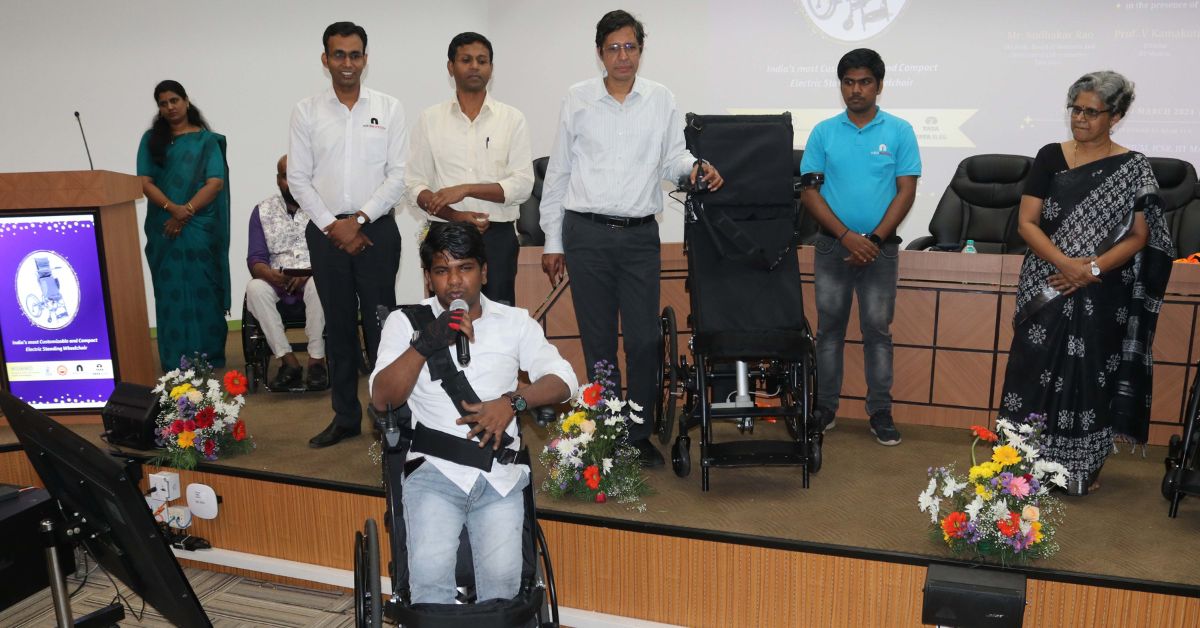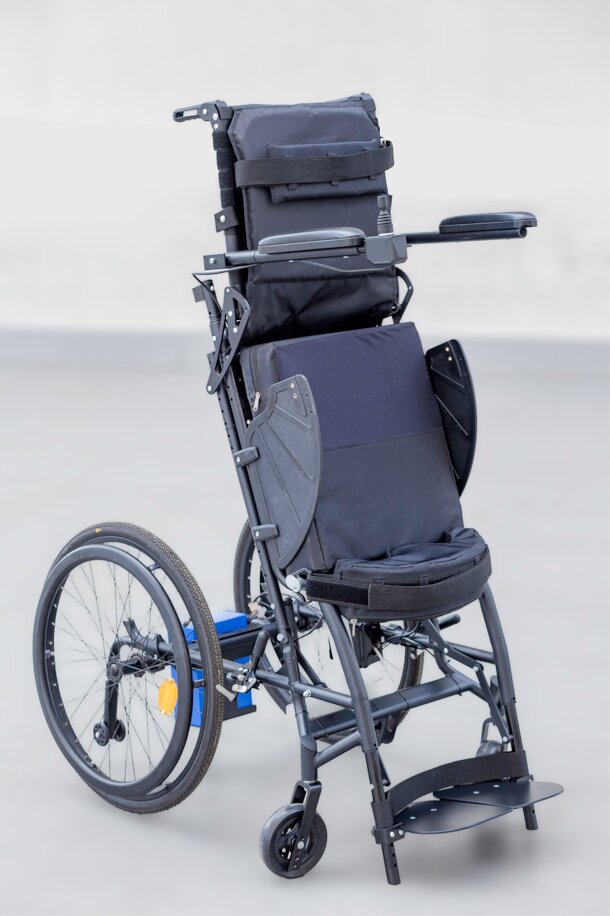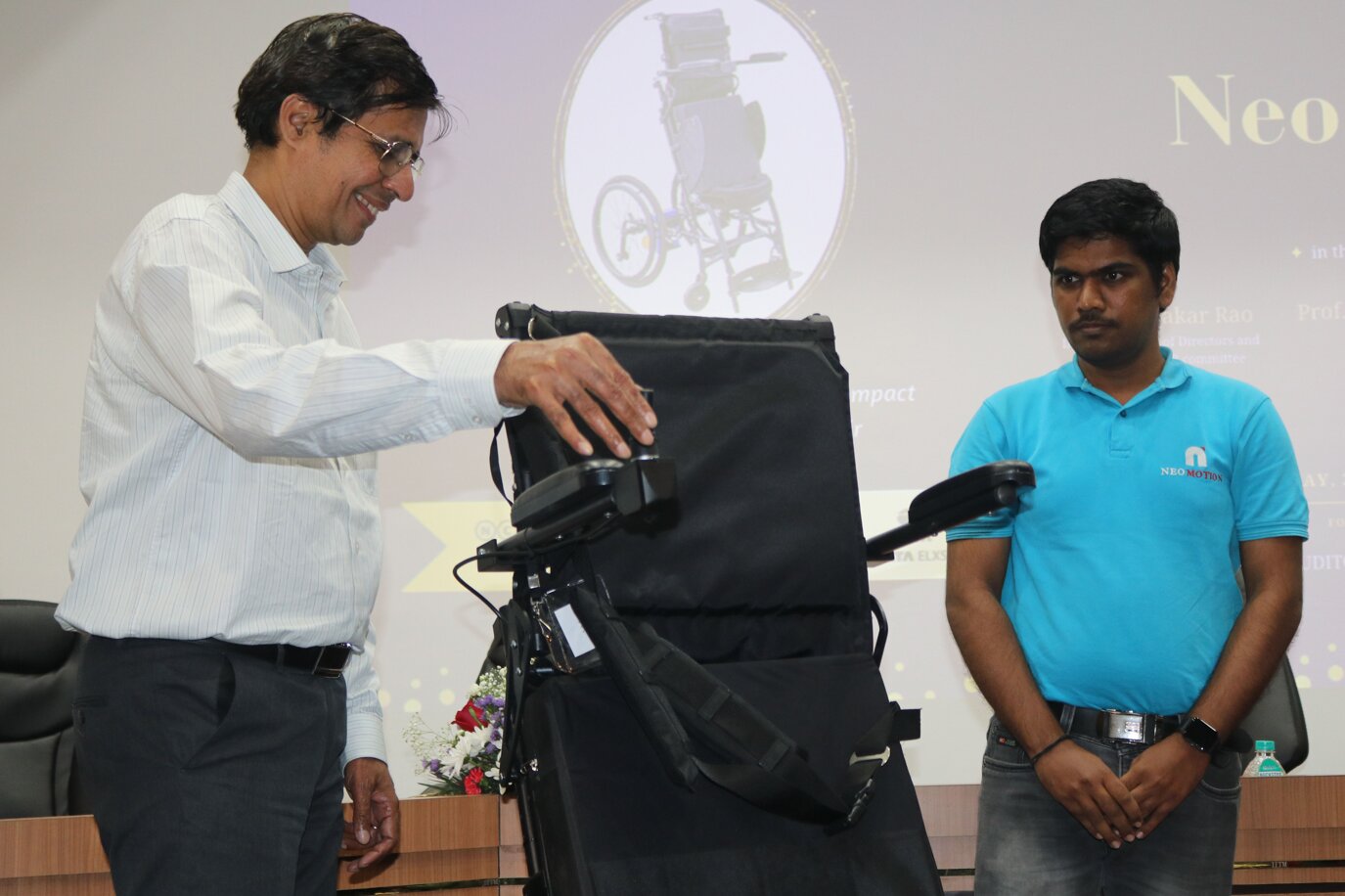At the mere touch of a button, a wheelchair user can now effortlessly transition from a sitting to a standing position thanks to the NeoStand — an indigenously developed and customisable electric standing wheelchair. Developed by researchers at the TTK Center for Rehabilitation Research and Device Development (R2D2) from the Indian Institute of Technology (IIT) Madras, this groundbreaking assistive device was launched on 20 March 2024, at the institute campus.
According to a press release issued by IIT-Madras, the project to develop NeoStand was led by Professor Sujatha Srinivasan, Head of R2D2, who also led the development of Arise, India’s first manual standing wheelchair, and NeoBolt, the country’s first motorised add-on for wheelchairs.
In an encouraging development, the NeoStand is being taken to the Indian market through NeoMotion — an IIT Madras-incubated startup founded by alumni from the institute.

Redefining the wheelchair experience with its user-centric design
Besides heading R2D2, Prof Srinivasan also teaches at the Department of Mechanical Engineering, IIT Madras. Articulating the vision of this project, she said, “Integrating standing function in a wheelchair provides health benefits as well as functional and psychological benefits to the user. Our first standing wheelchair was Arise, a low-cost mechanical design, specially designed for rural users, enabling standing and outdoor mobility for short distances.”
This compact standing wheelchair with an easy-to-use actuation system makes everyday activities — like engaging in eye-level conversations, reaching for a book or enjoying a meal standing by a counter — much easier for wheelchair users, and also provides real health benefits.
For most wheelchair users in India, the ability to stand is a real luxury. But standing is essential for better blood circulation, digestion, preventing pressure sores, etc. Besides physical health, there is also a real mental health and economic element to standing for wheelchair users.
According to this November 2013 academic paper published in Physiotherapy Canada, “Prolonged standing has been shown to have beneficial effects on various body functions and structures. In addition, time spent in a standing position can give wheelchair users a sense of confidence and equality through face-to-face contact with the non-disabled community.”
“Using a standing device can provide opportunities to connect with the outside world, enhance memories from the past, and promote hope for the future,” it adds.
Justin Jesudas — head of operations at R2D2 with 14 years of lived experience as a tetraplegic and an elite para-athlete — says, “Wheelchairs enable us, and it is a safe space for our mobility and to perform daily activities. The ability to stand with just a push of a button makes the wheelchair even more inclusive, helping tetraplegics to stand independently.”
Currently, wheelchair users are often dependent on external help and some need to use orthoses to stand. For users with compromised upper body strength, this is a significant challenge, and a manual standing wheelchair is inadequate, notes the press release issued by IIT-Madras.
That’s why in a conversation with The Better India, Professor Sujatha Srinivasan recalls, “The idea for NeoStand was fueled by encounters with individuals who, despite their desire for independence, found themselves reliant on others due to their physical limitations. The journey to developing NeoStand began in August 2021 with our observation that users of the Arise Standing Wheelchair, despite its innovations, were limited by the requirement for upper body strength to operate the arm and hand-powered standing function. This limitation sparked our determination to design a solution that could bridge this gap.”
“NeoStand, with its electric standing function, was conceived to empower a broader spectrum of users — including those lacking the upper body strength for manual operation — and to facilitate caregivers in providing support with less physical strain. Its compact design further addresses the need for a practical, space-efficient solution in urban environments,” she adds.
Besides putting less strain on the shoulders of caregivers or therapists in the hospital, the NeoStand also carries importance from a therapeutic standpoint. Caregivers or therapists can help the user practise standing gradually since NeoStand allows the user to stop at intermediate positions. This is very useful from a therapeutic standpoint.
Elaborating further, she describes how it promises users the freedom to sit for prolonged hours and stand comfortably when needed, reducing the risk of secondary health complications. “Its compactness ensures easy manoeuvrability through tight spaces, enhancing accessibility. The seamless transition between sitting and standing, with an option to pause midway, underscores its innovative approach to improving users’ quality of life and social participation,” she claims.

Developing the NeoStand
As stated earlier, the conceptualisation of NeoStand took root in August 2021 driven by a clear vision to enhance mobility solutions. As Professor Sujatha recalls speaking to The Better India, “The development process was marked by rigorous testing and refinement, with our team completing four design iterations to perfect the NeoStand. This iterative process was crucial in evolving the prototype into the market-ready product we are proud to introduce today.”
However, developing the NeoStand did pose challenges, particularly in achieving a sleek, compact design suitable for indoor use without compromising on smooth propulsion and functionality.
“Our team tackled these challenges through a blend of systematic engineering and thoughtful industrial design, ensuring that the final product not only met but exceeded our objectives. This process was a testament to our dedication to innovation and our relentless pursuit of solutions that enhance the quality of life for our users,” she claims.
Understanding NeoStand
NeoStand is engineered with four key systems: the seating system for comfort, the manual propulsion system for mobility, the electric standing system for effortless transition from sitting to standing, and the safety system to ensure secure use.
“The seating system offers tailored adjustments — including seat width, depth, and backrest height, for prolonged comfort. The manual propulsion is enhanced by ergonomic design elements, facilitating smoother mobility. The electric standing system employs a battery-powered actuator to smoothly transition the user to an upright position, while the safety system includes features like wheel locks and chest harnesses for added stability and security,” says Swostik Sourav Dash, Co-Founder and CEO at NeoMotion, speaking to The Better India.
“Powering the NeoStand is a Lithium-ion battery, chosen for its reliability and performance. This battery enables users to seamlessly transition between seated and upright positions up to 200 times on a single charge. Furthermore, the battery’s quick recharge capability — fully recharging within just four hours — ensures minimal downtime, enhancing the user experience by providing consistent support throughout the day,” says Professor Sujatha.
Priced at Rs 89,900, the NeoStand is positioned to make advanced mobility solutions more accessible, argues Swostik. “It is currently available for purchase directly through NeoMotion, with contact details provided on their website for ease of access. Our commitment to affordability extends beyond the price tag, as we explore various strategies to make devices like the NeoStand more accessible to wider communities, ensuring that advanced mobility solutions reach those who need them most,” he elaborates.

Corporate collaboration
The project to develop NeoStand was sponsored by the corporate social responsibility (CSR) arm of Tata Elxsi. Development and design, meanwhile, were led by the TTK Center for Rehabilitation Research and Device Development (R2D2) at IIT Madras and NeoMotion.
According to the press release issued by IIT Madras, Sudhakar Rao — IAS (Rtd); Member, Board of Directors, Tata Elxsi; and Chairman of CSR committee, Tata Elxsi — said, “The launch of a new product…for the differently abled signifies a turning point in our endeavour to foster inclusiveness and empowerment for individuals who face mobility challenges,” he said.
Speaking to The Better India, Professor Sujatha says, “Our collaboration with Tata Elxsi’s CSR arm provided not only financial support but also invaluable expertise in industrial design for some of our projects. Our partnership model extends beyond financial grants, aiming to encompass support for the extensive R&D work conducted at R2D2, as well as backing for the initiatives undertaken by the National Center for Assistive Health Technologies at IIT Madras,” she adds.
Moving forward, Professor Sujatha speaks of the “pressing need” they’re addressing — the provision of an adapted bus service.
“This service is crucial for transporting persons with disabilities to and from our centres, especially during the sports and cultural events we organise. Given the lack of accessible public transportation options in our cities, this initiative represents a vital link in ensuring participation and accessibility for all attendees. This kind of [corporate] support goes a long way in amplifying the impact of our work and underscores the multifaceted nature of the assistance we seek from our partners,” she adds.
(Edited by Pranita Bhat; Images courtesy IIT-Madras)
No comments:
Post a Comment